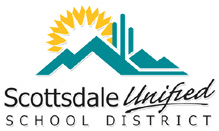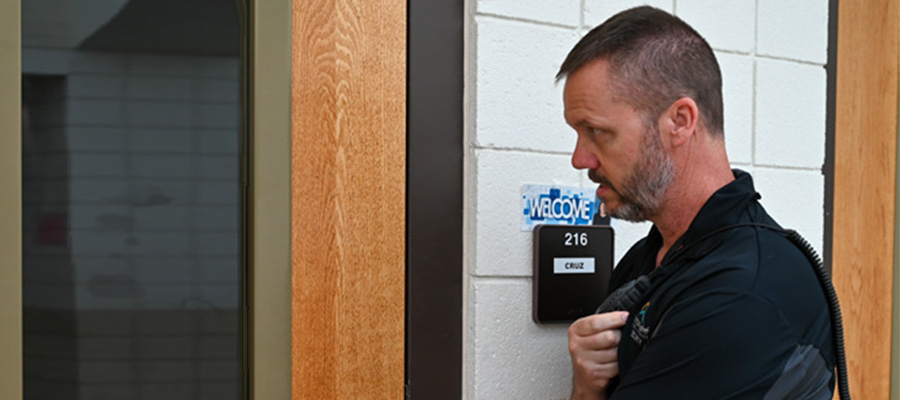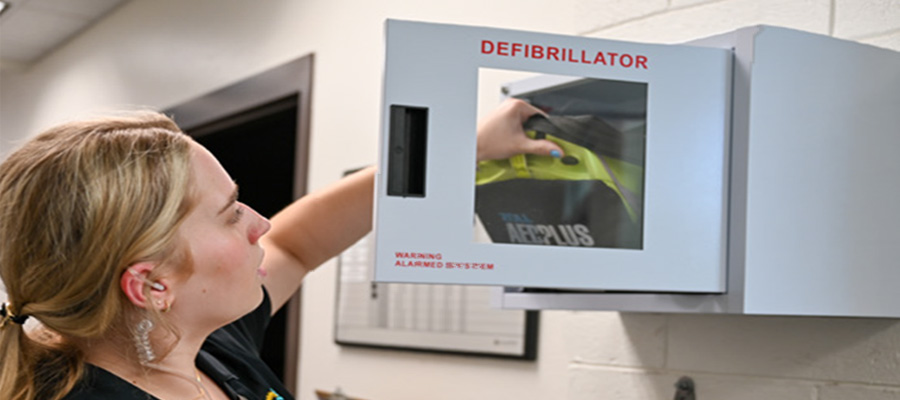Scottsdale Unified School District empowers staff and boosts safety
Makes the move from an outmoded system to state-of-the-art wireless connectivity.
The mass shooting at the Robb Elementary School in Uvalde, Texas in May, 2022 resulted in the deaths of 19 students and two teachers, with 17 others injured. In the wake of this horrific event, school administrators, teachers, and parents across the U.S. found themselves asking the same question—what if it had happened here? Leaders at the Scottsdale Unified School District (SUSD) in Scottsdale, Arizona did more than wonder about the potential risk. They took action to protect their district.
“Safety is paramount here, and we knew that we needed to be able to communicate seamlessly in the event of an emergency, like a shooting incident,” says Josh Friedman, director of safety and security for SUSD. “We started looking for a new communication system right after the Uvalde shootings, because it reminded us of the urgent need for safety—during an emergency and every day.” Adding to that urgency? Friedman and many others in leadership roles at SUSD had children attending schools in the district.
Friedman and his team began to search for a new communication solution. Their goal was to replace the district’s outmoded handheld land mobile radios (LMR), which dated from the 1980s and were no longer providing reliable communication. After a thorough review of multiple options over the course of six months, SUSD selected a Verizon Push To Talk Plus (PTT+) solution for all non-security personnel, with a Mission-Critical Push To Talk (MCPTT) solution for all security and campus uniformed officers. For communication devices, SUSD chose 2,000 rugged Siyata PTT handsets for officers, classroom teachers, nurses, coaches, bus drivers, and other key personnel. This sophisticated but easy-to-use solution relies on Verizon Nationwide wireless connectivity, which provides enhanced reliability and broad coverage. The result? The Verizon solution is cutting costs, boosting reliability, enhancing communication, enabling new capabilities—and significantly helping to improve safety. But while a technology upgrade might seem like an obvious next step, SUSD faced some daunting issues along the way.

Addressing the needs of a large district with an entrenched solution
SUSD is no ordinary school district. Its 21,000 students are spread across 29 physical campuses—including fifteen elementary schools, three K-8 schools, six middle schools, and five high schools, including one online high school. The geography covered by the district includes a large swath of central Arizona, including most of the cities of Scottsdale and Paradise Valley—as well as sections of the cities of Phoenix and Tempe. The scale of a new communication system paralleled the significant size of the district. After all, SUSD employs 2,600 full-time equivalents (FTEs), including about 1,500 teachers. Friedman and his team were facing a major communication technology upgrade, one that they wanted to keep streamlined for the district and simple for its staff.
Wrestling with an outmoded solution
Users of the outmoded land mobile radios (LMRs) had problems with reception and coverage throughout such a large district. The radios didn’t work well between schools and there was zero connectivity once users left the confines of the district, such as buses traveling to regional sporting events. Reception was sporadic, and teachers and drivers often found themselves reaching for their personal cell phones when their radios went dead.
Keeping the system running was a real challenge for Friedman and his team. “The majority of the problems with the old system stemmed from the fact that it was more than 20 years old,” recalls Friedman. “It had experienced minor upgrades over time, but some of the technology that we were using couldn’t even be upgraded anymore. We were stealing parts from one system to make another one work.” On top of the technical challenges, the older system was expensive to maintain and operate.
But there was one advantage to the status quo—users were familiar with the old system. And familiarity breeds complacency. “Our users knew the system well,” says Friedman. “Any change was seen as potentially difficult. And the size of the district made change even more complicated.”
We chose Verizon because of our ongoing relationship with them with other solutions. So it made real sense to rely on Verizon when we wanted to upgrade our core communications.
Josh Friedman, Director of Safety and Security of SUSD
Moving into the wireless world
SUSD considered upgrading its radio system, or choosing from several wireless solutions. After a proof-of-concept demonstration with key decision-makers, SUSD chose Verizon as its partner for a state-of-the-art wireless solution. The decision came down to two core factors according to Friedman—technical strengths and a strong partnership. “There are a lot of solutions out there with push-to-talk or similar capabilities,” he says. “We chose Verizon because of our ongoing relationship with them with other solutions. So it made real sense to rely on Verizon when we wanted to upgrade our core communications.” As a final incentive, the cost of the system was lower than the cost of continuing to operate its radio system.
The comprehensive Verizon solution provided all of the elements that SUSD needed, including:
- Verizon Mission-Critical Push to Talk (MCPTT): communication platform featuring emergency priority capabilities
- 2,000 Siyata mobile devices: Android-based handheld devices featuring large-capacity battery packs, simple operation, high-volume speakers, and other usability advantages
According to Friedman and others, the deployment of the Verizon wireless solution went very smoothly. “I think we launched the solution in about a week,” he says. “After a month, everything was settled down and more than 1,500 handsets were being used by everyone—transportation personnel, classroom teachers, special-education teachers, nurses, athletic trainers, site administrators, district office personnel, and others. “We worked closely with Verizon to answer any questions and solve any issues,” recalls Friedman. For example, to simplify roll-out of the new Verizon Wireless system, Verizon personnel pre-programmed hundreds of handsets, each assigned to a specific user so that callers could always be identified. And Verizon worked closely with SUSD to optimize coverage throughout the sprawling district. “It’s part of our close partnership,” says Friedman, “and a win for all.”
Winning over converts with reliability and convenience
Did SUSD staff like the new devices—and a new way of communicating? “They adapted quickly to the new system,” recalls Friedman. “We did some PowerPoint training but very little in-person training. We just trained the supervisors of each school and the security staff. Then they trained everyone else.”
The simplicity of the new devices won over even the most change-aversive staff members, according to Friedman. “The old radios had lots of buttons and an antenna, and you had to program the right transmission frequency,” he says. The radios were used by all, so they tended to be unreliably maintained, while the mobile handsets are assigned to specific users. “The new devices are smaller, simpler, and easier for our users to manage.” For example, the old radios had to sit in a special dock to charge, while the new devices use a standard charger.

Streamlined communication and increased safety
Greater usability and convenience for all users was just the beginning of the impact of the new Verizon wireless solution. Here are just some of the other benefits:
- Clear, reliable communication within the district and beyond
With Verizon connectivity, gone are the communication deserts between district buildings. And school personnel can stay connected to the district even when they travel far beyond the district. “The biggest benefit is that we’re able to communicate no matter where we are,” says Friedman. “We had an incident recently where one of our people was a 45-minute drive away and I was able to talk to him like he was sitting next to me.” Verizon installed network extenders within communication-challenged buildings, such as laboratories or buildings with cinderblock walls, ensuring complete coverage from the Verizon network, known for its fast network connectivity.1
- Empowered, informed, connected school resource officers
Every SUSD school resource officer—police officers assigned to all of its middle and high-school campuses— has a wireless device. These boots-on-the-ground responders can communicate with each other and key district personnel. They can also connect with the appropriate public-safety partners, including police, fire, emergency management, and dispatch centers. Every key public-safety partner organization—has a SUSD mobile device in their department and at their fingertips, so they are in constant contact with the school district. And in the case of an emergency, responding officers would know what’s happening before arriving on site.
- A heightened sense of safety
Is the district safer now with the Verizon solution? “Absolutely,” says Friedman, who spent 23 years in law enforcement before joining SUSD. “In the past, we couldn’t connect with our public safety partners because they were just too far away. Now they can hear everything that’s going on in our schools like they’re sitting right in the classroom with us. They can use GPS to know exactly where everyone is. It gives me great security to know that officers know what’s happening, so they can respond quickly and appropriately.”
- A more connected community
“Unfortunately, in this day and age, we see bad things happening in any number of places,” says Kristine Harrington, director of communications and marketing at SUSD—and mother of a middle-school student in the district. “But we’re doing everything we possibly can to help prevent incidents, as well as be able to respond appropriately to all situations. Getting these devices in the hands of teachers, administrators, coaches, and everyone else makes a very big difference to the entire community— including parents. Now I’m more confident that my daughter is safe at school.”
- Easy management that keeps the district self-sufficient
The old solution required a lot of work and expense to manage. The new devices are managed via portal, enabling SUSD to designate groups, add or adjust users, and do more device maintenance tasks—without requiring outside help from Verizon or a third party. This approach keeps the district self-sufficient and provides a simple, cost-effective way to manage the system on an ongoing basis.

Unfortunately, in this day and age, we see bad things happening in any number of places, but we’re doing everything we possibly can to help prevent incidents, as well as be able to respond appropriately to all situations.
Kristine Harrington, Director of Communications and Marketing, SUSD
Mother of a middle-school student in the district
Empowering more users and inspiring other districts
What’s ahead for SUSD? At this point, the district is still adding users and experiencing the early glow of a new, more efficient communication infrastructure. “Honestly, I just want to keep using the system,” says Friedman. “We’re very happy with where we are, and with how the new system works. We just want to give our people a chance to continue to acclimate and use their devices, every day.”
SUSD has provided devices to other local school districts, so they can see the benefits of the solution for themselves. “There’s a district just north of us that shares similar police dispatch contacts and officers,” says Friedman. “We’ve loaned them about a dozen of our devices so they can test them.”
If school leaders react as positively as Friedman at SUSD, these districts may soon leave their radios behind and move ahead with Verizon wireless connectivity that simplifies communication, empowers everyone from classroom teachers to safety personnel—and helps to improve safety for all.
Descubre más
To learn more about how wireless connectivity can help with campus safety, contact Verizon at 844-825-8389 or visit verizon.com/K12.
Neither the Scottsdale Unified School District nor any of the persons quoted herein were compensated in whole or in part for participating in this case study.